| |
ICF Insulated Concrete Forms
ICF Insulated concrete forms are a formwork for concrete that has polystyrene insulation incorporated.
It might be almost pure polystyrene or it might be wood chips cemented into blocks with some polystyrene inside.
Either way, they all tell you to only pour a few blocks high in one go and to be very gentle getting the air out of the concrete.
They might look easy, especially in an exhibition, but they are likely to either burst, lean, stretch and twist or they can fall over. And they can leak.
BS 8102:2022 warns that ICF for basement construction can be risky and expensive to cure leaks. See 5.1.3 and 11.1.d.3.
LABC Warranty Technical Manual Version 11 states, on page 489 "Basements formed from ICF construction will not be acceptable".
|
|
|
The only Building Regulation that is absolutely compulsory for basement construction, is C2. Resistance to moisture. You have to prove your basement walls are resistant to moisture. As the two warnings above suggest. You won't have ICF any more if you go chasing leaks.
These are quotes from BS8102:2022: "have increased risk of failure and are potentially difficult to repair so remediation can be extensive and costly"; "All repair methods and materials should be approved by a structural engineer", adding to the complexities and costs.

ICF also makes other obligations to meet the Standard difficult and expensive. At 6.2.5 the Standard states "The need for continuity in the waterproofing protection should also be determined when selecting a type of protection. In most circumstances, the protection should be continuous (typically from DPC level or 150 mm above ground throughout the below ground structure)."
At 3.7 it suggests sticky-back membranes, which I think don't stick and they damage too easily, should only be used on an impermeable structure. This makes sticky-back membrane unsuitable for ICF unless polystyrene has been stripped off one side and cracks and voids repaired. The LABC Warranty manual makes the same point on page 29: "external adhesive membrane systems on permeable construction is precluded".
A waterproof structure is achieved far more easily, as well as more cheaply and more successfully, pouring waterproof concrete into timber formwork strong enough to remain straight even as all the air is vibrated out.
Then repairing any visible flaw before work continues and the flaw gets out of reach.
A lot of people have read my various editions of this page telling you not to use ICF and a lot of them challenge me saying this brand or that won't fail.
What I am certain of is, no ICF insulating concrete form can be certain to give you a basement structure waterproof from the concrete alone.
Building with ICF because it looks simple adds the costs of external render and internal drainage if you are to properly meet BS8102.
This web site is about casting your basement to be fully waterproof from the structural concrete alone.
In that context, no ICF Insulated Concrete Forms come close.
There are a 100 brands or so. If any were really any good you would be able to buy them through builders merchants.
They are a very old idea that has not, and will not, catch on. Beco was here shortly after WWII. Polarwall, Quad-Lock, Nudura and Reward are the brands I tried or used from 2004 till 2013.
The NEW BS8102:2022. "Protection of below ground structures against water ingress - Code of practice"
I review the new Standard here.
Your architect probably sat through a free presentation from an internal drainage company. One of them, Maclennan, has updated its web site here. It describes the costs added using ICF for basement construction.
Thermal Mass recently got added into SAP calculations.
Thermal mass is the ability for the heavy construction material to even out temperature changes by storing or releasing heat.
ICF Insulated concrete form sales people will tell you that the concrete core in ICF insulated concrete form is great thermal mass. But that is a lie. Part of your SAP calculation includes the Admittance Value (AD): "the resistance to heat flow at the surface of the material". By insulating between your thermal mass and your room you will probably reduce your 'Thermal Mass Parameter' from 500 or so (better than good) to around 70 (worse than poor). More on thermal mass here.
The real choice is between heating/cooling just the air or making use of thermal mass.
I tend to think that if you won't get any direct sunlight into your basement, therefore no solar gain, that your basement should be insulated inside only so you only heat and cool the air.
But if one side is glazed and south facing I would prefer to insulate outside the basement wall and let the sun heat up my concrete walls to release free heat when it gets cooler.
|
|

|
My method uses a lot of timber. Most of which gets re-used in the house or sold on, so it is usually very cheap.
I used to use ICF insulated concrete forms. I used different brands many times from 2004 to 2013. What is good about ICF insulated concrete forms are DIY simplicity, no kickers and making use of the timber bracing for your scaffold.
My formwork method with timber is fused with these three ICF insulated concrete form benefits.
These walls have already been filled to half height. Now the formwork has been completed to the top and the wall is ready to fill to full height. Filling in two pours avoids the honeycombing in concrete that is one cause of leaks.
|
|
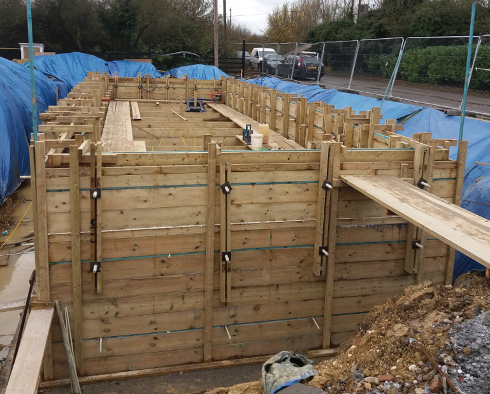
|
This basement was built by the selfbuilder with a few of his mates and some help and product from me.
|
|
|

|
|
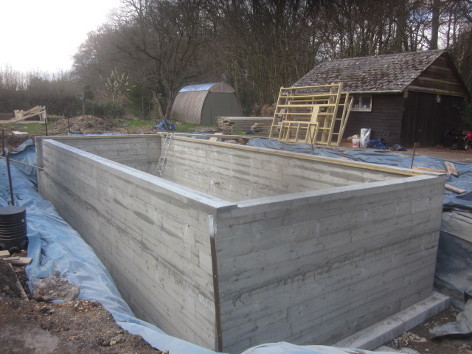
|
I gave him a free waterproof guarantee that his concrete and concrete joints would have no visible ingress of water for as long as I was alive and able to fix any leaks. That was in 2015.
Today that would cost:
-
Additive to make his concrete waterproof. £34 per m³. About £1,200 for this basement.
-
Training and Supervision of concrete pours £300 a visit. 3 visits usually £900.
-
Poker hire £40 a day, 1 poker to use and a spare just in case. £120.
-
Fibreglass rods to get the slab level. About £42 for this basement.
-
Fibreglass rods through the walls cast in leaving no holes. About £260 for this basement.
-
Nuts for rods. About £335 for this basement.
-
Steel waler plate hire. £1 each for up to 4 weeks. About £150 for this basement.
-
I also have excellent, strong, external drainage membrane costing less than £4.25 a m²
The guarantee comes free if you buy all the above as appropriate and you do the work as I show you.
More evidence of failures with ICF Insulated concrete forms
You may not need to read any more.
You cannot get a waterproof concrete guarantee with ICF insulated concrete form because the concrete additive supplier cannot inspect the concrete and get voids filled before he issues the guarantee.
FIRST MAJOR REASON NOT TO USE ICF INSULATED CONCRETE FORM.
Heating/cooling just the air. For instance: ICF insulated concrete form, timber frame, SIPs.
Please take a look at this other page about insulation. It opens in a new window. About half way down I have a case study. look for the pink insulated concrete form house. A couple's basement was built with 50mm/75mm ICF insulated concrete form and their house walls above ground with 50mm/100mm ICF insulated concrete form.
Soon after they moved in they fitted sensors on everything and found that during the first cold month they spent £26 on energy. They expected that success to continue and to sell excess electricity to the grid over the Summers and get that back.
But 3 years later I returned and instead of near zero energy cost they were spending £1,000 a year.
They aren't storing any heat in their walls, they had to install air conditioning in their bedroom and their Ground Source Heat Pump got more and more expensive as it froze their ground that failed to warm up again over Summer.
ICF insulated concrete form failed to save any energy.
|
|
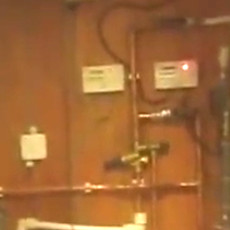
|
Here you see Nudura that apparently cost £120,000 4 years ago.

|
|

Twice this much was bought, for two houses. After the first they refused to go through the pain of using it again.
There is also some concern about it being flammable.
It is for sale VERY CHEAP if I haven't put you off.
It is in Kent near Lamberhurst.
|
SECOND MAJOR REASON NOT TO USE ICF INSULATED CONCRETE FORM.

|
|
Insulated concrete form is great to put together and still looks straight and plumb before you put concrete in.
But the reality is that that it stretches, leans and bursts under the weight of wet concrete.
Walls stretch and lose their dimension as the weight of wet concrete inside forces the wall to get longer and pushes panels apart. One wall getting longer makes the wall round the corner curved.
|
|
 These polystyrene panels spread after the concrete was setting.
These polystyrene panels spread after the concrete was setting.
|

|
|
ICF Insulated concrete form often bursts at corners.
Bursts and concrete pouring out is common.
ICF Insulated concrete form relies upon something built in crossing the gap and supporting both sides at once. At corners that strength isn't there because double sided formwork becomes single sided opposite the inside of the wall round the corner.
The insulated concrete form only holds where the panels are whole and double sided.
This means that when you trim insulated concrete form to make openings the right size, walls the right length and walls the right height you get problems.
|
Perhaps you won't use ICF insulated concrete form and you don't want to use my timber method either.
That's fine. You can still use my rods so you leave no holes with traditional plywood shutters or most systems you hire in. The rods are 18mm diameter. You can still enjoy a completely waterproof basement structure if you use a different formwork. As long as you obey my other rules such as no kickers and maximum 2m high in any pour.
A brief description of my formwork method. It is very simple, it does not require a kicker and there are no holes left through it. If you have piles or underpinning they can be one side of your formwork.

|
|
We construct it all the way round in one go but only to half height.
First the props are put together and fixed in place. You can see that the wall will be upright and straight.
Next the scaffold boards or 6x2 one side are screwed to them putting in the rods as you go.
Then the timber the other side, the strongback timbers, plates and nuts.
|
|
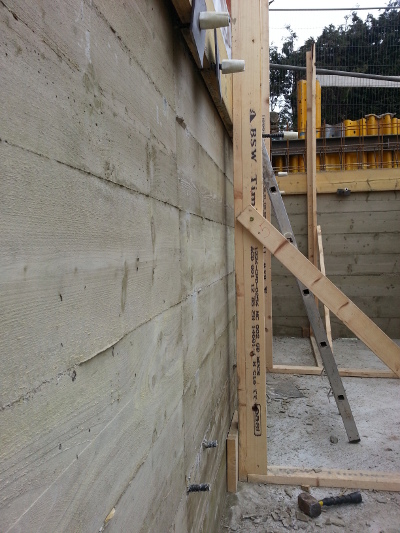
|
This is how we cast completely waterproof basement walls and completely air tight house walls.
From here onward I go into far more detail trying to convince you not to use ICF insulated concrete form.
If you have already firmly made up your mind you might want to stop reading here.
ICF Insulated Concrete Form
Note the corner marked A.
Note also the enlarged detail showing the top of a prop.
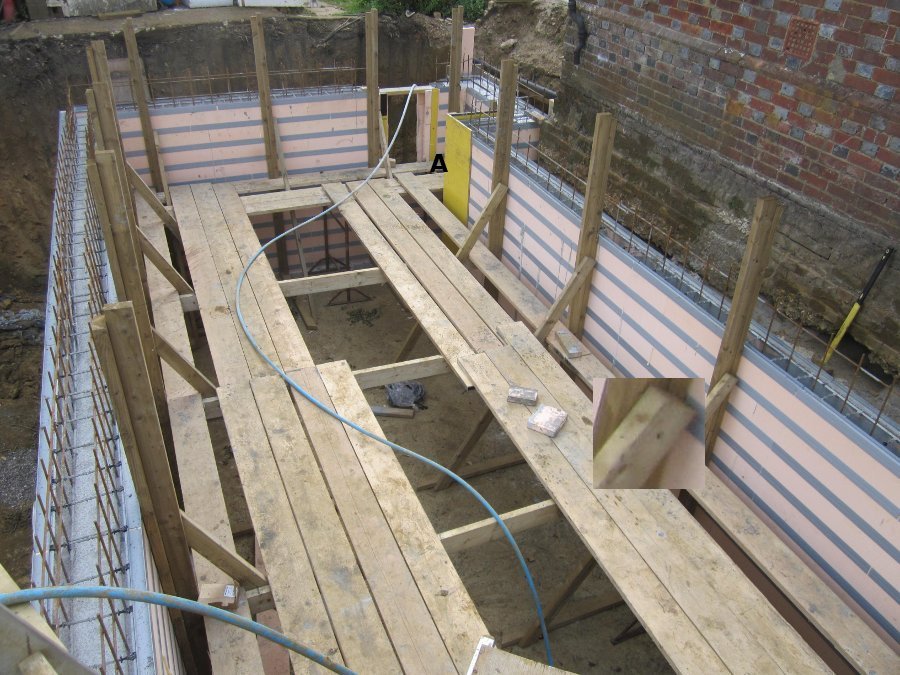
|
|
Resin Rod and Nut Method
Single sided resin rod against underpinning and double sided resin rod under construction by the customer.
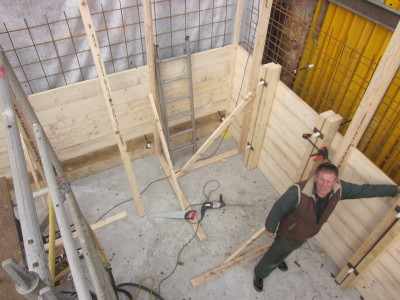
|
|
After many years on big construction sites I began building domestic basements with ICF insulated concrete form in 2004. I tried different brands, reduced the height of the panels, added ply at corners, poured in 2 pours, made much stronger braces, developed safer scaffold, and so on.
Having tried and tried to succeed with ICF insulated concrete form and to not have bursts, bent and bowing walls or leaks, has led to a number of very good innovations.
- No concrete kickers. Concrete kickers sink when properly compacted or they get made very badly. Kickers are notorious for requiring repair and being expensive to waterproof.
- Using 4x2 and hex head washered coach screws to make props that double up as scaffold. All the screws come out. All the timber is good for another use.
- I incorporate some U bars throughout the wall steel to hold it all perfectly upright putting no pressure on the formwork.
- Using completely waterproof concrete instead of membranes, tapes, strips or pumps with no additional labour whatsoever.
- Traditional formwork relies upon steel threaded rods throughout that are withdrawn (through plastic sleeves) leaving hundreds of holes to fill. Resin rods are cut off flush and are waterproof through the wall.
- Supervising the work.
Note from the interim report of the Grenfell Tower disaster: "Compliance, enforcement and sanctions processes are too weak".
Note also that the new edition of BS8102:2022, which replaces 2009, highly recommends supervision to reduce the leaks through the structure.
I supervise all the concreting with my admixture. I provide pokers I know will do the job properly. You will do as I say because you want my guarantee.
Supervision means a lot more, if not everything, Right First Time.
-
Removing the formwork to see that the concrete is faultless, and doing something about it if it isn't.
-
Cutting the cost of exactly the same insulation by buying it as large sheets. The most thorough way to fix insulation might be with 25mm of rockwool fixed first, then the rigid insulation fixed with screws. The concrete will be air tight and the rock wool will do something about any gaps between the rigid boards.
My timber formwork is much stronger than any ICF insulated concrete form. It is much cheaper yet better than any traditional formwork (in the hands of anyone but professional formwork carpenters). The concrete can be properly compacted so you will get a better result - and if it is Waterproof you want then it is Waterproof you will get.
ICF insulated concrete forms are usually just polystyrene or wood chips. If you fill them carefully, gently and without compaction you will leave voids inside. If you vibrate them to get rid of the voids, absolutely necessary to make it waterproof, no system of wood chips or polystyrene is strong enough. Wood chips are formed into blocks and concrete is not complete throughout the wall. Wood chips will let water through.
Traditional formwork is 18mm ply backed by 4x2s and upright soldiers, both sides, slammed against the kicker and squeezed against the plastic tube that the threaded rods go through. It takes many years of experience to gain the skills required. A dedicated team follows on to cosmetically cover all the blemishes - not to carry out thorough repairs - and certainly not to make waterproof repairs.
There are some very distinct advantages of timber formwork over ICF insulated concrete form:
- Removing the timber will let you see that the concrete is good and repair it if necessary.
- Timber will be stronger and less likely to burst; especially at corners where most if not all ICF insulated concrete forms are weaker, even with bespoke corner blocks.
- Timber will be stronger and less likely to stretch in length under the load of concrete.
- Timber can be fabricated to be a single sided formwork against underpinning.
I tried and tried, with experience of over 50 ICF insulated concrete form basements, to fill and compact the concrete properly and make the ICF insulated concrete form strong enough not to stretch, expand, lean over or burst. None of them. None of them are strong enough. Any ICF insulated concrete form basement wall that kept its shape is not properly full of concrete.
|
|
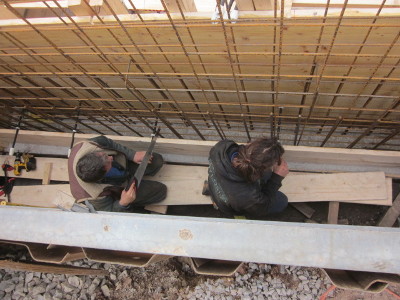
|
If you are contemplating a swimming pool always use this timber formwork. insulated concrete form is a waste of money because the concrete is a much better substrate for tiles and you can easily place insulation the other side before you backfill.
ICF

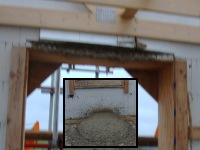


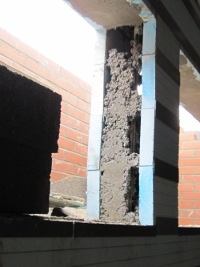
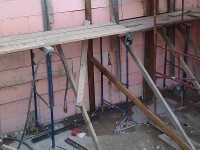
And here you
see emergency
bracing where
polystyrene
is bulging
under the
weight of
concrete.
|
|
I sold/used a white Canadian ICF insulated concrete form for 15 basements, then tried a green Canadian ICF insulated concrete form once, used plain ICF insulated concrete form boards 300mm high 19 times, the same, plain ICF insulated concrete form boards 200mm high 15 times and I once attended another brand's pour as the concrete additive supplier.
I have heard about most of the rest from the concrete pump operators, many of whom have pumped my concrete many times, got to know me and chat freely.
All ICF insulated concrete forms either fail or they are left full of voids (unless poured one course at a time, in which case the issue will be joints leaking).
The Beefed Up plain board system, with boards 200mm high instead of 300mm, used half as many plastic rails again, and more than 50% more ties because I reduced the spacing between them. So it cost about £8 a square metre more, with the same insulation, to make it strong enough not to burst with my concrete inside.
I used this beefed up version 15 times by the end of 2012. Every one of those 15 customers complained about the mess at corners and dimensions changing once the concrete was inside.
The panels no longer bulged out into a curve, neither did they burst, but the walls still stretched in length.
Both these polystyrene systems spread 6mm or so, even after the concrete was setting.
Spending more just for strength, the insulation being exactly the same, still did not provide the quality customers want because dimensions changed.
No brand of ICF insulated concrete form, beefed up or not, keeps its shape if the concrete is vibrated thoroughly enough to be waterproof.
Do not use ICF insulated concrete form with waterproof concrete now that my better system is available.
| |
This is a close up of the corner marked A in the photo above. The panels opened enough for concrete to squeeze out making the dimension wrong and creating a right mess.
|

|
A
|
|
|
|
|
|
DIY Timber Formwork.
Insulation added later.
Easy to erect timber formwork easily strong enough for waterproof concrete and easy enough for any competent self builder. Easier than ICF insulated concrete form because you can screw two bits of timber together. You cannot screw ICF insulated concrete form to ICF insulated concrete form.
I used the resin rod method single sided against underpinning and for double sided retaining walls many times.
The secret is to keep using the timber. Formwork should only cost £17.50 a m² (2018 prices) if used again and sold on or used permanently elsewhere. 100mm of waterproof insulation added later might add about £12.50 a m².
-
First fix props made from reusable 4x2,
-
fix one side of your scaffold boards to the props 7 courses high,
-
on top of the first board put 1m lengths of roof batten with a 20mm gap. These gaps are where the threaded resin rod, thin spacer nuts and big strong nuts go, so that you don't have to cut, notch or drill the reusable boards,
-
and 2no. 6x2 timber strongbacks either side.
-
remove the timber after the concrete has set and re-use all of it for more formwork and eventually use your 4x2 in your stud partitioning.
All the timber is re-used or sold on so it is very cheap.
For single sided formwork against underpinning and concrete piles resin the threaded bar into the concrete behind and build in the same manner filling between the single sided formwork and your underpinning.
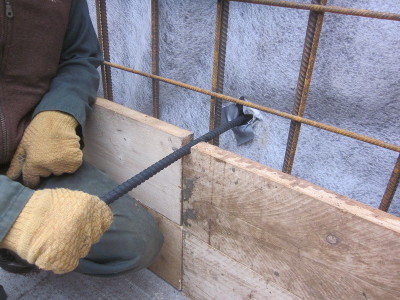
Remove the props and uprights the day after the pour and the nuts and scaffold boards after the concrete has hardened.
Cut the resin rods off flush after they are finished with.
Inspect the concrete.
Add probably 100mm of waterproof insulation outside before you backfill.
I have another page helping you to plan and by your timber formwork.
The page after that is the FORMWORK MANUAL.
|
Traditional Formwork
Traditional formwork needs a kicker to clamp against either side. Kickers always leak and they are very difficult to waterproof later.
Traditional formwork leaves walls full of holes after threaded steel rods are removed.
To be cost-efficient they cast walls in sections and move panels with a crane or big digger. More joints create more leaks.
Traditional and hired formworks are far from a DIY system, you need years of experience or else instead of hiring for 4 weeks you will hire for many months.
|
|
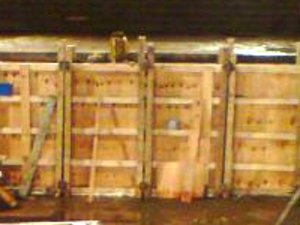
|
|
This photo is a link to a site with
what they call a classic example
of a failed kicker joint.
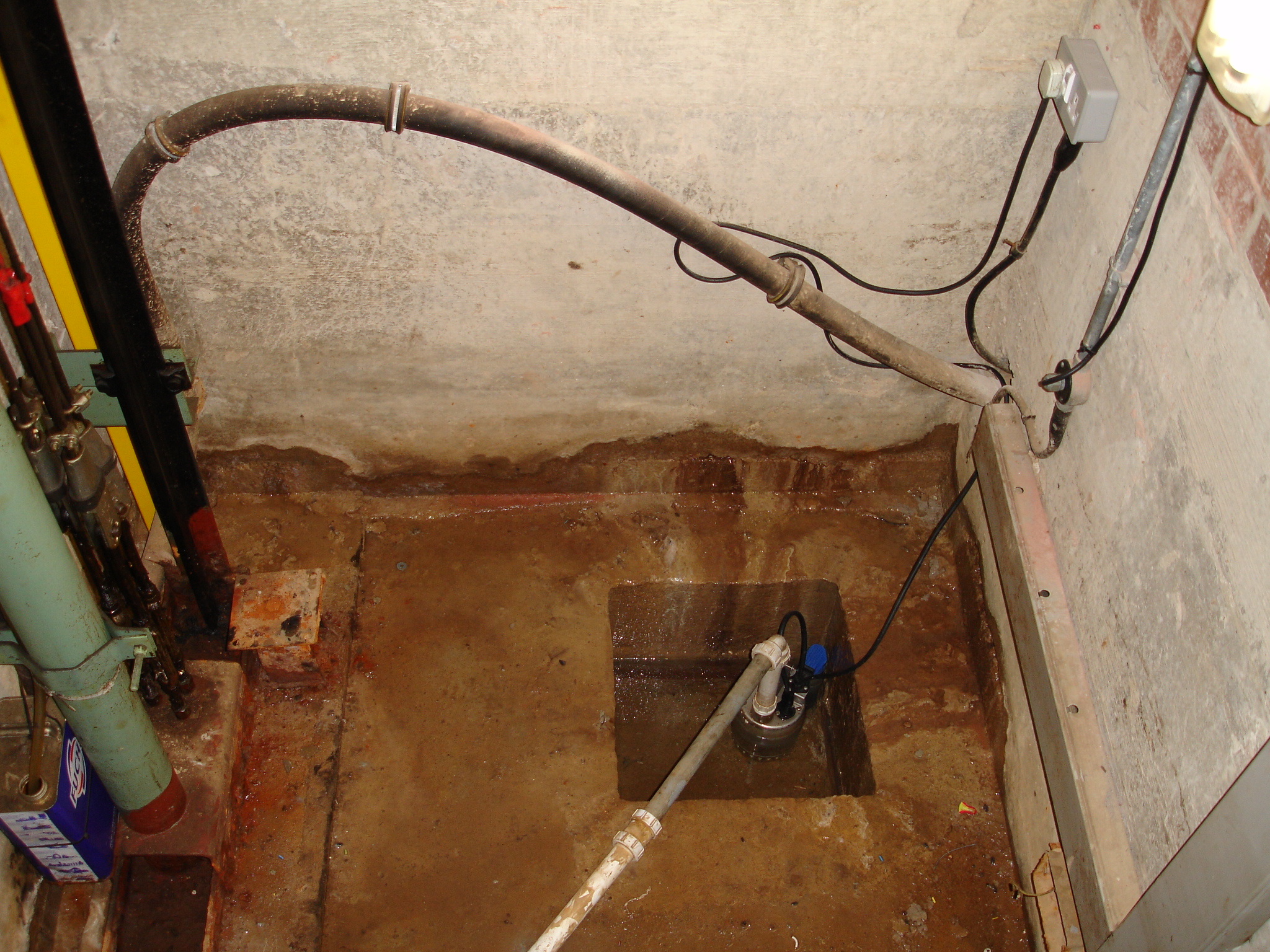
|
Concrete against underpinning and concrete piles.
|
Traditional Single Sided Shutter.
The bottom is pushed against a kicker.
The big pans are assembled and lifted by crane.
To be efficient with the hire cost they cast walls in short sections and move panels along daily, not giving the concrete any chance to cure properly.
This is not a solution for a domestic basement, which is why ICF insulated concrete form is cast close to piling or underpinning, not against it.
|
|
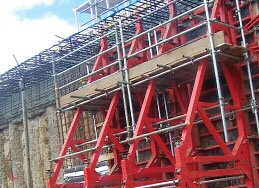 |
This is the sort of set up normally required to pour against piles with a single sided shutter. I would question whether anyone could do a good job pouring such height, but apart from that this stuff is clearly not going to be cheap nor moved around by a couple of men.
ICF Insulated concrete form against concrete.
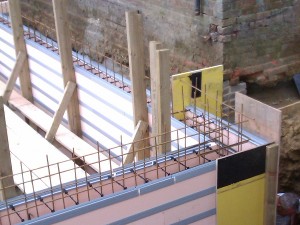 |
|
All ICF Insulated Concrete Forms rely upon being double sided. Therefore they need to be built independently of underpinning.
That means leaving a space in between that needs to be filled up somehow.
|
It also means leaving insulation in between which is probably a complete waste as well as a waste of space.
The side of a basement against underpinning is against very thick concrete the other side of which is underneath the building being extended. There is a strong scientific argument that no actual insulation would be needed against this wall because any heat lost would take a very long time to escape to open air, which is the definition of Insulation.
|
|
|
|
DIY Timber Formwork against concrete.
Actually cheaper than double sided timber formwork because there need only be timber one side if the other side is the underpinning or concrete piles.

Using the right resin to anchor threaded rod into the concrete is simple. You don't even need to be accurate because the threaded resin rod is flexible and still just as strong.
|
Another regular user of different brands of ICF insulated concrete form, who would agree to build and fill ICF insulated concrete form for anyone, sent me this (years ago now) after I sent him a friendly email saying that a pump operator had described his team, during one of our pours, a torrid day they had experienced the week before. I am keeping it anonymous, obviously.
"the burst occurred at a T junction where an internal ICF wall joined the outside and although they had braced it with a bit of 12mm ply it was not enough, but the final straw was that the 10mm aggregate from **** had at least two stones that were 40mm at least. When they cleared up the concrete they found these two stones and one plastic web that had been broken off!! The client was on site and was happy with the end result and concluded the causes were not with my men on site - in fact he found the stones and web! We have experienced at least one burst on nearly all of our ICF jobs and there is not an identifiable pattern to the causes. We have had bursts on full blocks in reasonable sized walls about 3 courses up which has to be the block. We have
used self compacting and stiff mixes with pokers, we have tried delaying concrete trucks between pours, we always work around the walls so as not to fill up from one point and none of it is a guarantee against bursts!!
I have to say that I have never been comfortable with ICF for basements and upset **** the other day when I told them so - for the reasons you state of not being sure the concrete is correctly compacted but also the fact that concrete does not chemically bond to the webs leaving a potential microscopic passage for water at each rib."
Like me, this company also experimented with non-ICF insulated concrete form ways and whilst they had not publicly stated they will not use ICF insulated concrete form again they did not want to.
At long last a very experienced practitioner (me) has gone public with the problems common to every brand.
Design Professionals do not like ICF insulated concrete form because they cannot see that the concrete is complete throughout.
Contractors do not like ICF insulated concrete form because it is fragile, bursts and carrying concrete back up in buckets is heart as well as back breaking and overtime is expensive.
Customers do not like ICF insulated concrete form afterwards because walls bulge and lose their shape so rooms will be smaller after the plasterboard hides the problem. And rendering the outside means having to shave foam off first to get a flat plane but losing insulation they paid for.
I think ICF insulated concrete form is finished.
|
|
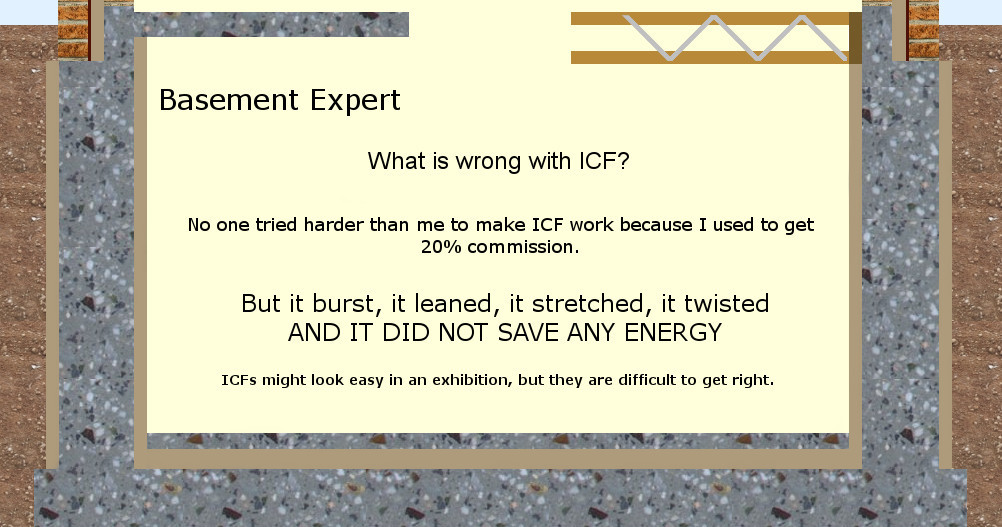

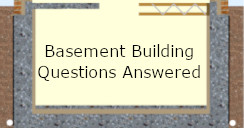
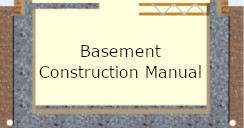












 These polystyrene panels spread after the concrete was setting.
These polystyrene panels spread after the concrete was setting.
















